Hurricane eMatrix
List of Activity Sheets » Infrastructure repair and restoration
Roadway and Bridge Inspection and Repair
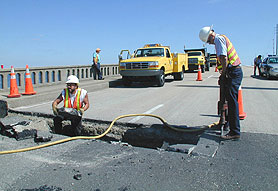
This picture shows actual disaster site work conditions and may not illustrate proper safety and health procedures.
Activity Description
- This activity sheet outlines hazards that apply to civil engineers/inspectors, equipment operators, divers, construction workers, and others while they are involved in road or bridge inspection and repair.
- Other activity sheets also apply to specific tasks or job categories (heavy equipment operators, divers, and work zone safety); see related activity sheets below.
- Torrential rains, flooding, and storm surge from Hurricanes Katrina and Rita (2005) had potential to damage roads and bridges. These structures must be inspected after each disaster that washes out roads, carries significant debris down streams where it can impact bridges, or otherwise damages transportation routes. If roads or bridges are found to be damaged, they must be repaired, or demolished and replaced.
- Workers involved in these activities use a variety of heavy equipment to perform inspections, and to conduct debris clearing, demolition, and repair work. Additionally, work near or over water (bridge work) might be performed from a vessel or by divers.
- Response and recovery workers conducting this operation may be employed by Federal, State, local, and private employers. Review How to Use This Matrix in the introduction for a discussion of how this information may apply to different workers.
About the Activity Sheet
This activity sheet does not provide an in-depth analysis of OSHA standards and regulations and cannot address all hazards. It does not increase or diminish any OSHA requirement or employer obligation under those requirements. It is intended as a guide and quick reference for employers and response and recovery workers. The Matrix captures major activities involved in hurricane response and recovery, highlights many of the hazards associated with them, and recommends beneficial work practices, personal protective equipment (PPE), and other exposure control methods. Employers must evaluate the specific hazards associated with the job/operation at the site where the work is being performed.
Employers are responsible for providing a safe and healthful workplace for their workers. OSHA's role is to assure the safety and health of America's workers by setting and enforcing standards; providing training, outreach, and education; establishing partnerships; and encouraging continual improvement in workplace safety and health.
The Hazard Exposure and Risk Assessment Matrix for Hurricane Response and Recovery Work provides a general overview of particular topics related to current OSHA standards. It does not alter or determine compliance responsibilities in OSHA standards or the Occupational Safety and Health Act of 1970, or the equivalent State Plan standards and requirements. Because interpretations and enforcement policy may change over time, you should consult current OSHA/State Plan administrative interpretations and decisions by the Occupational Safety and Health Review Commission and the courts for additional guidance on OSHA compliance requirements. Employers should modify their procedures as appropriate when additional, relevant information becomes available.
Activity-Specific Sampling and Monitoring Information
- Workplace monitoring results show that structural iron and steel workers involved in transportation restoration activities can experience noise exposures that exceed allowable levels (i.e., OSHA's PEL).
- For safety and health monitoring data and sample results, see the Summary of Activity Sampling Data and Safety and Health Monitoring Information.
General Recommendations
Key Engineering Controls and Work Practices. See general recommendations document.
Personal Protective Equipment. The general PPE is recommended for all response/recovery tasks/operations; only the additional PPE that may be needed for a specific hazard is noted below.
General PPE includes:
- Hard hat for overhead impact or electrical hazards
- Eye protection with side shields
- Gloves chosen for job hazards expected (e.g., heavy-duty leather work gloves for handling debris with sharp edges and/or chemical protective gloves appropriate for chemicals potentially contacted)
- ANSI-approved protective footwear
- Respiratory protection as necessary-N, R, or P95, filtering facepieces may be used for nuisance dusts (e.g., dried mud, dirt and silt) and mold (except mold remediation). Filters with a charcoal layer may be used for odors
Recommendations Specific to Hazards Associated with Roadway and Bridge Inspection and Repair
Key Engineering Controls and Work Practices
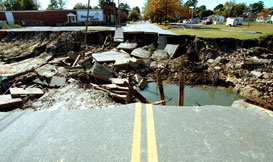
- Limit access/set up controlled access zones until stability and structural integrity is known
- Conduct an engineering survey of the structure and any adjacent structures that might be affected
- Install temporary structural support (shoring, bracing) adequate to protect response and recovery workers
- If demolition is needed, develop a written survey that addresses how the structure will be dismantled safely
Key Engineering Controls and Work Practices
- See Heavy Equipment and Powered Industrial Truck Use activity sheet
- See Crane Use activity sheet
- See Use of Aerial Lifts activity sheet
Additional Personal Protective Equipment
- Hearing protection-see Noise hazard
- When working from an aerial lift, use a body harness that is properly attached (or body belt for tethering or restraint use only) for fall protection
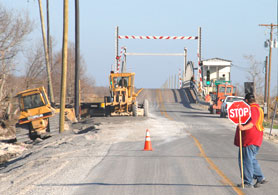
Key Engineering Controls and Work Practices
- See Work Zone Safety and Traffic Control within a Work Area activity sheet
Additional Personal Protective Equipment
-
ANSI/ISEA 107-2004 compliant high visibility safety apparel and headwear
Key Engineering Controls and Work Practices
- Remove or secure objects (glass, structural members) that may fall while workers work under them
- Use debris netting, sidewalk sheds, canopies, or catch platforms to reduce hazards from falling objects
Key Engineering Controls and Work Practices
- Assume that electrical lines are energized until proven otherwise. Lines and other conductors may become reenergized without warning as utilities are evaluated and restored after a disaster
- Inspect the work area for downed conductors and do not go near, drive over, or otherwise come in contact with them
- Downed electrical conductors can energize other objects, including fences, water pipes, bushes, trees, and telephone/CATV/fiber optic cables
- Unless deenergized and visibly grounded, maintain proper distance from overhead electrical power lines (at least 10 feet) and/or provide insulating barriers
- Do not approach any gas leaks; if a gas leak is detected, secure spark-producing devices (e.g., engines, tools, electronic, and communications equipment) and evacuate the area until the leak is secured
- Contact utility company to assist in locating, marking, and shutting off/purging utility lines that may pose a hazard or may be impacted; ensure that lines have been purged as needed before beginning work
Key Engineering Controls and Work Practices
- Limit access/set up controlled access zones
- Use fall protection systems: guardrails, safety nets, or fall arrest systems
- Cover or guard holes and openings as soon as they are created. Covers must support two times the weight (body, equipment, materials) that may be imposed
Additional Personal Protective Equipment
-
Personal fall arrest system including harnesses, lanyards, lifelines, connectors, anchorages, and anchor points (as needed)
Key Engineering Controls and Work Practices
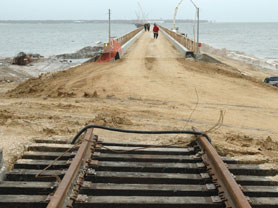
- Stay upwind of or away from dust-generating activities, and in particular those involving crystalline silica-containing materials like concrete, brick, tile, drywall, mortar, sand, or stone. When inhaled, the fine crystalline silica particles contained in the dust can become lodged deep in the lung, which can lead to silicosis and other respiratory illnesses
- Use water spray or mist to suppress dust generation, especially during operations that may create a lot of dust, such as cutting or sawing silica-containing materials, jack hammering, impact drilling, using heavy equipment, and demolishing structures
- Avoid using compressed air for cleaning surfaces
- Sample worker exposures to silica during dust-generating activities
Additional Personal Protective Equipment
- At a minimum, use respirators with N, R, or P95 filters for work with crystalline silica-containing materials (e.g., concrete, brick, tile, mortar). The use of N, R, or P100 filters may provide additional protection. Higher levels of respiratory protection may be needed for some operations (e.g., cutting concrete, sandblasting, mixing concrete)
- N, R, or P95 respirators may be used for nuisance dusts (e.g., dried mud, dirt, or silt) and mold (except mold remediation). Filters with a charcoal layer may be used for odors
Key Engineering Controls and Work Practices
- Identify building materials such as painted surfaces and pipes that may contain lead. Test materials as necessary
- Based on test results, perform an worker exposure assessment of the planned activities, that includes air monitoring and/or objective data, to determine if lead dust or fume may be generated at or above OSHA's action level (0.03 milligrams of lead per cubic meter of air (mg/m3))
- If so, then the activities must be done in compliance with 29 CFR 1926.62. This would include:
- Establishing a written lead compliance program
- Having a competent person conduct frequent and regular inspections of the jobsite, materials, and equipment
- Sampling worker exposures
- Using special equipment or methods to decrease lead-dust generation such as local exhaust ventilation, dust collection systems (on power tools), and good housekeeping practices
- Providing respiratory protection and protective work clothing
- Providing medical exams and blood tests before work begins and every six months, as necessary
- Ensuring that workers wash their hands and face before eating, drinking, and smoking
- Setting up and ensuring use of change areas and eating facilities that are separate from the work area
-
Limiting the wearing of lead-contaminated clothing in eating areas or away from the job site
- During certain tasks, workers must be treated as if they are exposed above the OSHA PEL (0.05 mg/m3) until an exposure assessment, which includes air sampling, is performed. For each of these tasks, OSHA has identified an exposure level on which to base decisions until an exposure assessment is complete. If planned activities include any of the tasks below, you must provide the following items while the exposure assessment is being performed: respiratory protection and PPE identified in 29 CFR 1926.62(d)(2), change areas, hand washing facilities, training, and biological monitoring. These tasks include:
- Where lead coatings or paint are present: manual demolition, scraping, and sanding; heat gun applications; power tool cleaning (with or without dust collection systems); cleanup activities where dry expandable abrasives are used; rivet busting; abrasive blasting (including enclosure movement or removal); welding; cutting; and torch burning
- Spray painting with lead paint
- Using lead containing mortar
- Lead burning
Additional Personal Protective Equipment
- Based on anticipated exposure, select respirator and protective clothing as required in 29 CFR 1926.62 for initial sampling and subsequent work where lead dust or fumes may be generated
Key Engineering Controls and Work Practices
- Inspect ladders for cracked, broken, or defective parts before use
- Do not exceed the load rating of ladders or scaffolds-remember that load ratings include people, tools, and equipment
- Set up ladders and scaffolds on stable surfaces
- Set extension or straight ladders at a 75 degree angle from the ground (1/4 foot back for every foot of rise) and provide 3 feet above an upper landing surface to ease climbing onto/descending from height
- Use non-conductive ladders (e.g., fiberglass) and exercise extreme caution when working near power lines
- Secure ladders that can be displaced by work activities; consider barricades at the base to keep traffic away
- Have a competent person inspect scaffolds before use
- Ensure that the scaffold is plumb, and braced and guyed to prevent tipping, swaying, and displacement
- Ensure that the scaffold is built on base plates and mud sills, or other firm foundations. Footings should be able to support the scaffold without settling or moving. Do not use unstable objects to support scaffolds
- Fully plank each scaffold on all working levels. For wood planking, use wood graded for the intended load
- Provide guardrails or fall protection systems on platforms 10 feet or higher
Additional Personal Protective Equipment
-
Fall arrest systems on platforms without guardrails 10 feet or higher
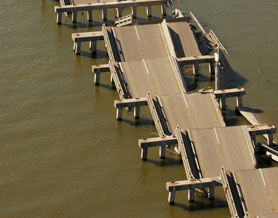
Key Engineering Controls and Work Practices
- Use additional protections, such as a lifesaving skiff and a ring buoy as appropriate
Additional Personal Protective Equipment
- All personnel should wear Coast Guard-approved Type I or II personal floatation devices
- Watertight boots with steel toe and insole as needed
Key Engineering Controls and Work Practices
- See Diving and Diver-Support Operations activity sheet
Key Engineering Controls and Work Practices
- Take care when navigating because landmarks, navigational aids, and underwater hazards may have shifted
- See Deep-Water Work/Boating Operations activity sheet
Additional Personal Protective Equipment
-
Coast Guard-approved Type I or II personal floatation devices
Key Engineering Controls and Work Practices
- Use ground-fault circuit interrupters (GFCIs) or double insulated power tools, or implement an assured equipment grounding program
- Inspect power tool condition (including any cords) and verify operation of safety features before use
- Do not use equipment that is defective, such as equipment with inoperable safety switches, missing guards, frayed/cut cords etc.
- Ground power tools properly
- Avoid standing in wet areas when using portable power tools
Additional Personal Protective Equipment
- Hearing protection-see Noise hazard
- Hand protection for cut- and abrasion-control and vibration dampening
- Eye protection appropriate to the impact hazard
Key Engineering Controls and Work Practices
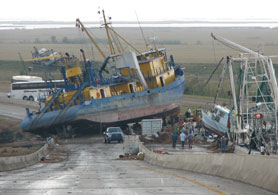
- Remove flammable and combustible materials from the area
- Do not perform "hot work" such as welding, cutting, or burning in areas where flammable, combustible, corrosive, or toxic substances are being used, stored, or may otherwise be present
- Maintain a fire watch during all hot work until material has cooled
- Ensure fire extinguishers and extinguishing agents are available in the immediate area
- Provide natural, exhaust, or forced ventilation to control exposure to the metal fumes and other contaminants being generated (e.g., generator exhaust)
- Ensure that pipes and other vessels are purged of hazardous materials
- Identify materials that will be welded, cut, or burned and that may contain lead, such as painted surfaces and pipes. Test materials and provide exposure controls identified in 29 CFR 1926.62 as necessary; see Lead hazard
Additional Personal Protective Equipment
- Gloves and protective clothing for the activity being performed
- At a minimum, filtered lenses and face-protection as appropriate for the activity being performed
- Respiratory protection based on anticipated exposure to metal fumes, including lead
Key Engineering Controls and Work Practices
- See Trenches and Excavations activity sheet
Key Engineering Controls and Work Practices

- Never attach a generator directly to the electrical system of a structure unless a qualified electrician has installed a transfer switch for the generator. If the structure's electrical system is not isolated, it may energize the utility's wiring system for great distances and create a risk of electrocution for utility workers and others in the area
- Always plug electrical equipment directly into the generator using the manufacturer's supplied cords or grounded (3-pronged) extension cords that are rated for the total anticipated load
- Do not overload a generator; it can overheat and create a fire hazard
- Ground and bond generators according to the manufacturer's recommendations; ensure that any manufacturer-required connections are secure before using the generator
- Keep the generator dry; protect with a canopy if needed; do not use it in wet or rainy conditions
- Carbon monoxide (CO) is a poisonous, colorless, and odorless gas that is produced by the incomplete burning of the generator's fuel. CO is harmful when breathed because it displaces oxygen in the blood and deprives the heart, brain, and other vital organs of oxygen
- Never use a generator indoors or in enclosed spaces such as garages and basements; opening windows and doors may not prevent CO from building up in those spaces. Do not use a generator outdoors near doors, windows, and vents that could allow CO to enter
- Ensure that a generator has 3 to 4 feet of clear space on all sides and above it to ensure adequate ventilation and cooling
- Before refueling, shut down the generator and allow it to cool
Additional Personal Protective Equipment
- Hearing protection-see Noise hazard
Key Engineering Controls and Work Practices
-
Place generators, compressors, and other noisy equipment at a distance or behind a barrier when possible
Additional Personal Protective Equipment
-
Hearing protection when working around potential noise sources and when noise levels exceed 90 dBA. A useful "rule of thumb"-if you cannot hold a conversation in a normal speaking voice with a person who is standing at arms length (approximately 3 feet), the noise level may exceed 90 dBA
Key Engineering Controls and Work Practices
- Segregate and store incompatible chemicals separately. For example, store solvents and oxidizers (e.g., peroxides) separately, and acids and caustics separately
- Secure compressed gas cylinders and ensure that they are stored properly when not in use (regulators off and valve caps on when not in use; separate oxygen and fuel gas by 20 feet or using a non-combustible barrier (5 ft high, fire-resistant rating of at least ½ hour))
- Store chemicals in containers approved and designed for chemical storage and mark all storage locations
- Store and handle hazardous materials in areas with natural or forced ventilation; do not store or handle in low-lying areas
- Isolate, secure and identify storage areas
- Prohibit smoking near storage areas
- Keep ignition sources at least 25 feet away from storage areas
- Ensure that fire extinguishers and extinguishing agents are available in the immediate area
- Bond and ground containers before dispensing flammable liquids. Reference 29 CFR 1926.152(e)(2)
Additional Personal Protective Equipment
- Gloves made of material that will protect user from chemicals handled
- Face shield or goggles with indirect venting. If a face shield is selected, eye protection must be worn under the face shield
- Coveralls or apron resistant to chemicals being handled
- Disposable boot covers resistant to the chemicals being handled
- A respirator and cartridges specific for chemical, as necessary
Key Engineering Controls and Work Practices
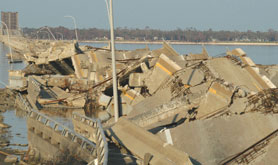
- Reduce the exposure to splash or aerosolized liquid hazards by limiting the number of people in the area and having those in the area stay upwind of water discharge areas
- Ensure that good hygiene, especially hand washing, is practiced before eating, drinking, and smoking. If clean water is not available, use an alternative such as hand sanitizer or sanitizing wipes
- Ensure that cuts and bruises are protected from contact with contaminated water
- Clean areas of the body that come in contact with contaminated water with soap and water, hand sanitizer, or sanitizing wipes
- If divers are involved, ensure divers and their equipment are appropriately decontaminated (fresh water shower/rinse at minimum) upon completion of dive operations-see Diving and Diver-Support Operations activity sheet
Additional Personal Protective Equipment
- Goggles if routinely working near splashing floodwater
- N, R, or P95 respirators may be necessary for exposure to contaminated water that may become aerosolized
- Watertight boots with steel toe and insoles
- Waterproof gloves for contact with contaminated water
Key Engineering Controls and Work Practices
- Confined spaces have limited means of entry or exit, are large enough to bodily enter, and may contain physical (e.g., mechanical, electrical, hydraulic, pneumatic energy; engulfment hazards; inwardly converging surfaces) or atmospheric hazards (e.g., atmospheres that are oxygen-deficient or oxygen-enriched, contain or may contain flammable gas, vapor or mist, airborne combustible dust, toxic substances, or any other atmosphere that is immediately dangerous to life or health). Examples include storage tanks, process vessels, bins, boilers, vaults, ventilation or exhaust ducts, sewers, tunnels, pipelines, and pits more than 4 feet in depth
- Hurricane-related events might introduce hazards or potential hazards into confined spaces. For example, a space might have a potential to contain a hazardous atmosphere due to the presence of decomposing organic matter, to the use of hazardous chemicals in the space, or to the performance of operations in the space, such as welding, cutting, or burning, that may create a hazardous atmosphere. Additional precautions must be taken to make the space safe for entry
- Evaluate the need for entry (i.e., placing any body part into the space)
- If entry is required, see Entry into Confined Spaces activity sheet
Key Engineering Controls and Work Practices
- If hazardous chemical containers are found or leaking materials are detected:
- Do not use spark-producing devices (e.g., engines, tools, electronic, and communications equipment) in the immediate area
- Take self-protective measures (i.e., move to a safe distance upwind) and contact hazardous material response personnel for evaluation/removal before continuing work in the area
Additional Personal Protective Equipment
-
Evaluate the need to revise protective clothing, respirator, and glove selection
Select any of the following potential hazards that can be associated with this activity in order to access relevant recommendations in the general recommendations document:
Additional Medical Needs
- Follow medical guidance and precautions outlined in the general recommendations document
- Workers who may be exposed above the action level for lead for a single day must be enrolled in an initial medical surveillance program. Additionally, workers who are exposed to lead levels at or above the action level for more than 30 days in any consecutive 12 months must be enrolled in a medical surveillance program, as outlined in 29 CFR 1926.62(j)
Additional Training Needs
- Follow general site- and task-specific training guidelines as outlined in the general recommendations document
- Workers shall be provided lead training before starting work involving lead exposures at or above the action level. See the general recommendations document and or 29 CFR 1926.62(l) for additional lead-specific training information
Related Activity Sheets
- Building Demolition
- Debris Collection
- Tree Trimming
- Sand/Sludge Removal
- Diving and Diver-Support Operations
- Deep-Water Work/Boating Operations
- Entry into Confined Spaces
- Trenches and Excavations
- Heavy Equipment and Powered Industrial Truck Use
- Work Zone Safety and Traffic Control within a Work Area
- Crane Use
- Use of Aerial Lifts
Other Resources and References
- 29 FR 1926.106, Working Over or Near Water. OSHA Standard.
- 29 CFR 1926 Subpart O, Motor vehicles, mechanized equipment, and marine operations. OSHA.
- 29 CFR 1926.251, Rigging Equipment for Material Handling. OSHA Standard.
- 29 CFR 1926.453, Aerial Lifts. OSHA Standard.
- 29 CFR 1926.550, Helicopters, Hoists, Elevators, and Conveyors. OSHA Standard.
- 29 CFR 1910.178, Powered Industrial Trucks. OSHA Standard.
- 29 CFR 1926 Subpart M, Fall protection. OSHA.
- 29 CFR 1926 Subpart I, Hand and power tools. OSHA.
- 29 CFR 1926 Subpart J, Welding and cutting. OSHA.
- 29 CFR 1926 Subpart X, Ladders. OSHA.
- 29 CFR 1926 Subpart L, Scaffolds. OSHA.
- 29 CFR 1926.62, Lead in Construction. OSHA.
- Using Aerial Lifts. OSHA Fact Sheet, (2005).
- Working Safely Around Downed Electrical Wires. OSHA Fact Sheet, (2005).
- Portable Ladder Safety Tips. OSHA Quick Card, (2005).
- Scaffolding. OSHA eTool, (2003).
- Falls. OSHA Fact Sheet, (2016).
- Respiratory Protection. OSHA Safety and Health Topics Page.
- NIOSH Respirator Selection Logic 2004. Centers for Disease Control and Prevention, (CDC).
- Using Portable Generators Safely. OSHA Fact Sheet, (2005).
- Manual on Uniform Traffic Control Devices (MUTCD). US Department of Transportation, Federal Highway Administration.

